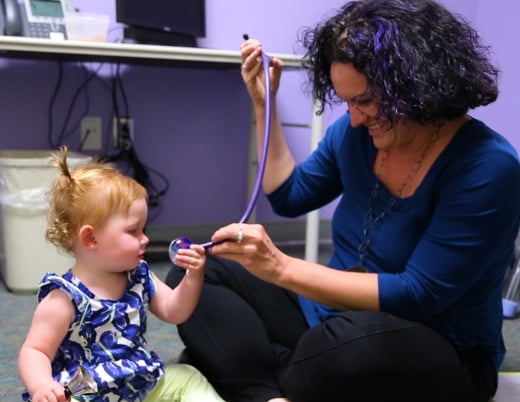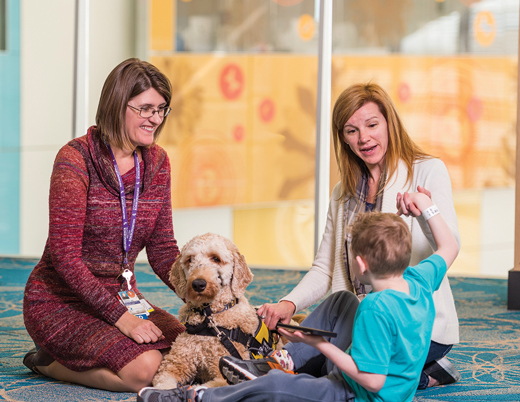How can a drug designed specifically for one patient help providers extend the benefits of precision medicine to more children?
More than a decade ago, Children’s Hospital Colorado ophthalmologist Emily McCourt, MD, diagnosed a young patient with retinitis pigmentosa — an incurable disease that was slowly degrading the girl’s vision. Through whole-genome sequencing, geneticists discovered a very specific gene mutation and recently, they developed a very specific treatment to address it. This year, the now-13-year-old patient received her first dose of the drug, tailor-made just for her, that aims to stop the disease’s progression in its tracks.
Diagnosing retinitis pigmentosa
The patient was just 2 years old when she first visited Dr. McCourt for issues with night vision. She had seen other doctors for her challenges with balance and insensitivity to pain, but this new symptom added to the puzzle in a troubling way. Dr. McCourt suspected retinitis pigmentosa, in which retinal cells break down over time, and tests confirmed the diagnosis.
“What was remarkable about that first exam was that I could tell she had retinitis pigmentosa, but we don’t usually diagnose this in toddlers,” Dr. McCourt says. “It’s usually diagnosed in teens and young adults, so I knew it was a pretty severe case.”
Even with Dr. McCourt’s findings, the patient’s other symptoms remained a mystery. Over the next several years, she worked to address and track the girl’s growing visual impairment, but it would be years until the family got a full diagnosis. That came in 2016, when Children’s Colorado geneticist Austin Larson, MD, joined the family’s care team. He used results from previously conducted whole-genome sequencing to identify two genetic mutations and offer a diagnosis at last — posterior column ataxia with retinitis pigmentosa, or PCARP.
The FLVCR1 gene and its impact on PCARP
PCARP is rare, but the mutation behind this particular case is even rarer. Most people diagnosed with the condition have mutations affecting both copies of the FLVCR1 gene within the protein-coding region, meaning that their bodies are unable to code for the production of a necessary protein. While the patient has a mutation affecting the coding region of one copy of the gene, the other copy is affected by a deep intronic mutation. Instead of losing its ability to code for the protein altogether, this copy of the gene makes an error in splicing the RNA template for the protein, mistakenly including genetic material that shouldn’t be there.
This deep intronic mutation turned out to be the key to a whole new world of options. That’s because, while there is nothing that can currently be done for the typical mutations behind PCARP, deep intronic mutations can be treated using antisense oligonucleotides, or ASOs. In 2019, after discussing this experimental treatment option with the patient and her family, the team began working with a lab at Boston Children’s Hospital led by Tim Yu, MD, PhD. They were interested in developing an ASO that could bind like a zipper to the specific region of the patient’s gene causing the splicing mistake. This would allow the gene to properly code for the typical protein. Researchers tested 15 different versions of the ASO on samples of the patient’s cells and found two possible winners that could partially restore function of the protein.
The team then began working with n-Lorem, a foundation focused on providing patients with personalized ASO therapies for free. n-Lorem fine-tuned the ASO design developed in Dr. Yu’s lab, funded further pre-clinical testing to understand possible side effects, and created a lifetime supply of this one-of-a-kind drug. Drs. McCourt and Larson then worked with the investigational drug team at Children’s Colorado to secure approval from the U.S. Food and Drug Administration to begin treatment.
Antisense oligonucleotides: a new frontier in PCARP treatment
The ASO isn’t a cure. It likely won’t reverse the patient’s vision loss, and it won’t address her other symptoms. What it may do is stop the progression of her vision loss. Since her initial diagnosis, the patient’s vision has declined from 20/40 to 20/200, and without this treatment, her visual impairment will worsen. And with her insensitivity to pain, vision is even more important, as it allows her to identify and properly care for infections or cuts she can’t physically feel.
“It’s still at a point where she can read with a big magnifier and she can navigate the world,” Dr. Larson says. “She has functional vision, and if it can be preserved at this level, that would be a huge difference in terms of her quality of life.”
In August, the patient received her first dose of the new drug. It is administered via injection into the vitreous of the eye, as ASOs need to be applied directly to the cells that they aim to affect. She’ll initially receive doses every three months before transitioning to a bi-yearly injection.
Along the way, Dr. McCourt will continue to closely monitor her patient’s vision to see how well the personalized treatment functions. She’ll employ objective visual testing, including visual acuity, light sensitivity, gait analysis and more.
“We don’t have any other studies to go on to say she’ll need it for five years, or she’ll need it for 10 years,” Dr. McCourt says. “We know we have enough medicine if she needs it and wants it. The protocol is written in a way that if any member of the team, including the patient and family, think that the injections are no longer beneficial, then we will stop.”
Charting the future of personalized medicine
This specialized drug is designed for one patient and one patient only, but its impact could extend far beyond this single child. It’s the first instance in which doctors at Children’s Colorado were able to bring a patient all the way from genetic diagnosis to specialized medicine, but Drs. McCourt and Larson are confident it won’t be the last.
Children’s Colorado is driving continuous improvements to its use of genetic testing and tailored therapies through the new Precision Medicine Institute, and Drs. McCourt and Larson teamed up to create a genetic eye clinic aimed at helping more patients like this one. They’ve already identified another patient with retinitis pigmentosa that could benefit from a similar approach to care.
What’s more, through the partnerships and processes created as a result of this one patient’s journey, they expect to be able to deliver results quicker and even more effectively.
“The goal is to keep doing this, because each time we do this, we learn a lot about how to diagnose patients earlier in the disease process, our diagnostic capabilities improve and we are learning how to get through this process quicker,” Dr. Larson says. “We hope to scale this up and to make it more efficient, to the point where it’s practical for more patients.”
Featured researchers

Emily McCourt, MD
Chief of Pediatric Ophthalmology
Ponzio Family Chair for Pediatric Ophthalmology
Children’s Hospital Colorado
Associate professor
Ophthalmology
University of Colorado School of Medicine

Austin Larson, MD
Austin Larson, MD
Pediatric geneticist
Genetics and Inherited Metabolic Diseases Program
Children's Hospital Colorado
Assistant professor
Pediatrics-Clinical Genetics and Metabolism
University of Colorado School of Medicine





 720-777-0123
720-777-0123










